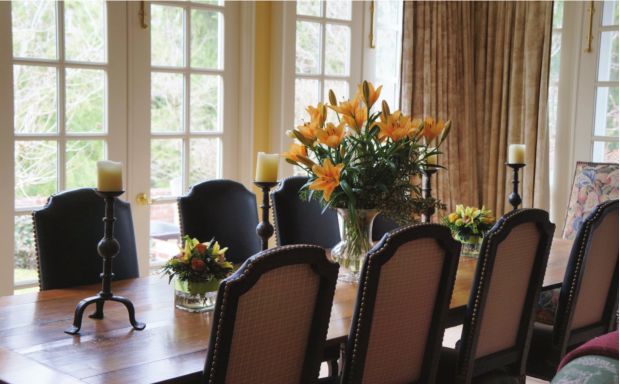
Use design concepts for aesthetics and practical living
Homes and landscapes are individual and personal. “Beauty is in the eye of the beholder” is a time-tested tradition in much of art and design. While art and beauty can depend upon individual preference, there are basic considerations to be made when designing and developing a home and its landscape.
Today with our splurge of information on television, magazines, the Internet, classrooms and in the public eye, it is important to get to “basics” – concepts to use in applying personal design. The “wow” factor is often a primary concern when seeking ideas and elements to include in home design. The foundation and practices of well-designed home interiors and landscape design can be overshadowed when you apply things that don’t work. The start of good design is knowing what you have and taking opportunities to work with it.
The key to great home and landscape design is the ability to take your individual situation, location, spaces and needs and distill them into the basics – needs and wants. To create your Springfield style, follow these guidelines. Use your space, place and case as the foundation for individual choices and actions inside and out.
Home and landscape are spaces utilized in a specific way by yourself and others. Design should include an individual evaluation and selection of elements that work for you. A front line response to room or garden issues should be to identify your existing condition, then your needs and, lastly, options to service the function and form of your situation. Researching ideas, topics, professionals and resources with experience and practice will help create your individual success.
Solid
interior and landscape design is functional and attractive. All too
often the attractive ideas you find supercede the functional aspects of
good design choices. A key to good design is to understand functional
needs then the aesthetic wants. Design is finding the fun in
fundamentals.
Design
concepts: space, place and case. In the development of a home interior,
garden and landscape, start with the concept, then move on to the
details. Design big and detail small. Plans and planning are the basics
of good design. Success is the result of preparation. Use planning to
identify what exists, your needs and wants, what should change and the
end result. Work from your end vision backward to where you are.
Planning should convey the three-dimensional aspects of your space.
Your space is your actual situation, the lay of the land or room as it exists. Describe your space in words or a plan
drawing. Seeing the space externally will help you plan it. Look at the
space’s context, surroundings, influences, environment and conditions.
Property
lines are invisible and only articulated on a plan. The scale and size
of interiors is often smaller than exterior spaces. Things outside have
weather and climate to be included in your choices. Scale is varied, so
utilize the space, movement and organization relative to its situation.
Your place includes
the existing areas, elements and conditions that will stay as is and
those that can and should be changed. Rooms have connections physically
and visually within your home while soil, existing trees, structures,
drive access and the like are often the “fixed” features within a
landscape.
Good inside
and outside design can create “wow.” Usually the “wow” is a result of
working with what you have. Utilizing your situation and planning it
results in making functional your limits or conditions. Designing with
your limits or constraints is a personal opportunity to make what you
have yours and attractive.
Your case is
the last interior and landscape design consideration. What do you have
and what do you want to do? Who is the user, what is the use, what is
wanted and needed? What will make the situation work? What will make the
situation more attractive? What is the best location for the uses and
needs? And what and why do you want change?
Good
design necessitates the right questions – not necessarily starting with
all the right answers. The best response to a tough question is “that’s
important enough for me to research and find the right answer.” Plan
your work and work your plan. Design, don’t just decorate.
Here
in Springfield you can seek out local materials, resources and sources.
While you may start by asking friends and looking online with
Pinterest, seek individual applications for your needs and wants. Buying
local is an opportunity to get what you want and need and to support
your community. Many local venues have collected, edited and picked
inventories. Remember that sourced materials are not found at garage
sales and cost more for the efforts made by vendors.
Gregory
M. Pierceall is an emeritus professor of landscape architecture from
Purdue University, West Lafayette, Indiana. He lives in Springfi eld and
is the owner of ReSource-Gallery and Home + Garden shops on Governor
Street.
